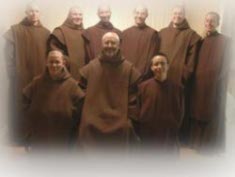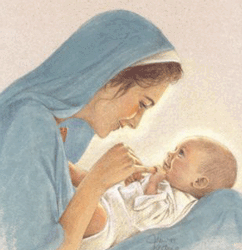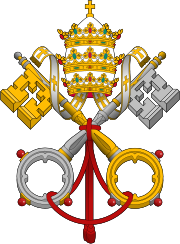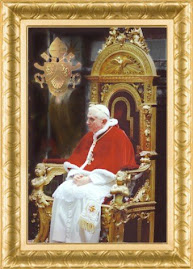 The Blessed Carmelites of Compiègne – July 17
The Blessed Carmelites of Compiègne – July 17
On July 17, 1794, the sixteen Carmelites nuns of Compiègne were guillotined in Paris, convicted of crimes against the state by the tribunal of the French Revolution. On this day they were born to eternal life. Mother Henriette de Jesus, renowned for her great beauty and strong personality, stood up to represent the other Carmelite sisters before the revolutionary tribunal and was remarkable for her heroic resolution. Since the prosecutor accused the Carmelites of being fanatics and counter-revolutionaries, she asked him to explain the meaning of those words. The irritated judge vomited a torrent of offenses against her, and then said: “It is your attachment to your Religion and the King.” Hearing these words, she replied, “I thank you for the explanation.” Then, addressing her companion Carmelites, she said: “My dear Mother and my Sisters, we must rejoice and give thanks to God for we die for our Religion, our Faith, and for being members of the Holy Roman Catholic Church.” She was the last one before the Prioress to mount the scaffold to die. To the end, she encouraged her Sisters to persevere. When a charitable person offered a glass of water to one of the Sisters, Mother Henriette told her: “In Heaven, my Sister, in Heaven we will soon have water aplenty to drink.” These Sisters knew that they were being put to death for their fidelity to the Catholic Church and the King, but they wanted the prosecutor to admit it out loud, because this would be a public witness of their martyrdom and an encouragement for them in face of the dangers of apostasy. This is why Mother Henriette was charged with asking that question. When the answer came, she was happy and transmitted it to her Mother and Sisters in religion. All of them shared that joy and went forward to die. Mother Henriette, who was very resolute, offered assistance to each of them until the end. Only the Prioress, Mother Teresa of St. Augustine, died after her, because she was the superior, and the Captain must always be the last one to leave the sinking ship.
The episode with the glass of water is beautiful. Certainly there were some Carmelites who were nervous facing the trauma of such a violent death. To drink a glass of water could give them some relief. When Mother Henriette saw that one Carmelite Sister was inclined to accept the offer, she was probably thinking: “This small sacrifice can be yet another pearl for her crown in Heaven.” So, she advised her to not take it, and gave this magnificent reason: “My Sister, in Heaven soon we will have water aplenty to drink.” She was clearly referring to Our Lord, Who is the source of all living waters, to the face-to-face contemplation of God that gives eternal happiness. The thirsty Sister understood that when she would receive her crown of martyrdom, it would have an additional star because she made that sacrifice.
Mother Henriette faced death bravely and encouraged the others. You can contrast Mother Henriette de Jesus with an imaginary personage in a popular novel, The Dialogue of the Carmelites by George Bernanos. The character was called Blanche de la Force and was presented as a weak and timid Carmelite Sister. She is an imaginary personage, but it is worthwhile considering her, because she represents a common character type. In his novel, Bernanos presented her as a Sister who had panicked when the other Sisters were taken by the revolutionary soldiers and sentenced, and for this reason had apostatized from the Order. She was no longer living inside the Carmelite community, but she went to see the execution of her former companions who would suffer martyrdom that day. The Sisters were chanting the Veni Creator in chorus and, one by one, they walked up the steps to the scaffold to be guillotined. When she saw this, she was moved by a grace, stepped out of the mob and, singing, joined the cortege to be executed along with them.
The two attitudes of both religious – Mother Henriette and Sister Blanche – express well the different paths of Divine Providence for different souls - the different marvels God works with His chosen ones. For some He chooses the glory of repentance – this is one of the glories attributed to the Apostles who fled during His Passion. For others He gives the strength that he gave to Mother Henriette of Jesus, that is, to view death from a distance and face it bravely, walking toward it joyfully. This was what He did with Mother Henriette, who helped all the others face their martyrdoms. These are two different paths God chooses to lead and direct souls. Seeing these two contrasting paths, you can admire the infinite beauty of God in the unity and variety of His ways. This is why the Saints are different from one another and why there are different schools of spirituality in the Catholic Church. It serves to show the beauty and richness of Holy Mother Church, a reflection of the beauty of the Heavenly Jerusalem.
The episode with the glass of water is beautiful. Certainly there were some Carmelites who were nervous facing the trauma of such a violent death. To drink a glass of water could give them some relief. When Mother Henriette saw that one Carmelite Sister was inclined to accept the offer, she was probably thinking: “This small sacrifice can be yet another pearl for her crown in Heaven.” So, she advised her to not take it, and gave this magnificent reason: “My Sister, in Heaven soon we will have water aplenty to drink.” She was clearly referring to Our Lord, Who is the source of all living waters, to the face-to-face contemplation of God that gives eternal happiness. The thirsty Sister understood that when she would receive her crown of martyrdom, it would have an additional star because she made that sacrifice.
Mother Henriette faced death bravely and encouraged the others. You can contrast Mother Henriette de Jesus with an imaginary personage in a popular novel, The Dialogue of the Carmelites by George Bernanos. The character was called Blanche de la Force and was presented as a weak and timid Carmelite Sister. She is an imaginary personage, but it is worthwhile considering her, because she represents a common character type. In his novel, Bernanos presented her as a Sister who had panicked when the other Sisters were taken by the revolutionary soldiers and sentenced, and for this reason had apostatized from the Order. She was no longer living inside the Carmelite community, but she went to see the execution of her former companions who would suffer martyrdom that day. The Sisters were chanting the Veni Creator in chorus and, one by one, they walked up the steps to the scaffold to be guillotined. When she saw this, she was moved by a grace, stepped out of the mob and, singing, joined the cortege to be executed along with them.
The two attitudes of both religious – Mother Henriette and Sister Blanche – express well the different paths of Divine Providence for different souls - the different marvels God works with His chosen ones. For some He chooses the glory of repentance – this is one of the glories attributed to the Apostles who fled during His Passion. For others He gives the strength that he gave to Mother Henriette of Jesus, that is, to view death from a distance and face it bravely, walking toward it joyfully. This was what He did with Mother Henriette, who helped all the others face their martyrdoms. These are two different paths God chooses to lead and direct souls. Seeing these two contrasting paths, you can admire the infinite beauty of God in the unity and variety of His ways. This is why the Saints are different from one another and why there are different schools of spirituality in the Catholic Church. It serves to show the beauty and richness of Holy Mother Church, a reflection of the beauty of the Heavenly Jerusalem.
after Tradition In Action - Prof. Plinio Corrêa de Oliveira



























